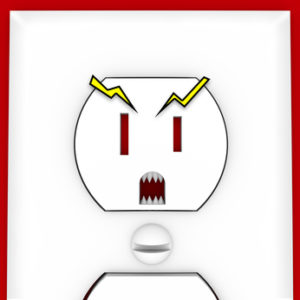Electrical outlets often last for decades, but they may need replacement at any time. Overuse, poor installation, and plain bad luck can cause an electrical outlet to crack or lose the grip on plugs.
You know an electrical outlet should be replaced when:
- Electrical plugs are falling out.
- It’s not just one device that has a problem—the outlet feels loose with most plugs.
- Cracks or other damage are visible on the outlet’s face plate.
The hazards of a bad electrical outlet
Worn-out, faulty electrical outlets present a safety problem as well as an annoyance. Any damage will worsen over time and house fires can even occur due to an old electrical outlet.
When an outlet gets loose, the wiring emits heat and energy in the form of an electric arc. This heat melts plastic and metal, creating the risk of fire. What starts with a loose terminal inside the unit can quickly become a much bigger threat to your property.
 Of course, the daily annoyance of a loose electrical outlet receptacle is enough to spur you into action. You plug in your cell phone to charge only to find hours later that it never charged because the outlet couldn’t hold onto the plug. Lamps constantly flicker and appliances turn off while you’re using them. If you can’t rely on your outlet, don’t delay fixing it.
Of course, the daily annoyance of a loose electrical outlet receptacle is enough to spur you into action. You plug in your cell phone to charge only to find hours later that it never charged because the outlet couldn’t hold onto the plug. Lamps constantly flicker and appliances turn off while you’re using them. If you can’t rely on your outlet, don’t delay fixing it.
DIY: removing and replacing an electrical outlet
Many people can handle a DIY electrical outlet replacement but only with thorough understanding of the electrical system and the right tools for the job. This includes a voltage tester, needle-nose pliers, lineman’s pliers, screwdrivers and a drill. You also need to become familiar with how the outlet functions, so you can be comfortable with handling and manipulating the wires.
Want to replace your own electrical outlet? Here are the key points you should know:
- Power must be off. Turn off the circuit breaker and use a voltage tester to be 100% certain. If you are working on multiple outlets in a room, be aware that the outlets may be controlled by multiple breakers.
- Look for damage. When removing the outlet, look for burn marks and other evidence of damage to determine all the necessary replacements.
- Ground wires must be carefully handled and re-connected appropriately. This typically involves bending the end of the wire around a ground screw using needle-nose pliers.
- You can use outlet shims or spacers to fix issues with a loose receptacle, but the outlet should be inspected for potential or existing damage that could lead to bigger problems.
Calling Your Local Electrician to Fix an Electrical Outlet
If you are inexperienced or uncomfortable with handling electrical wiring, go ahead and call a professional. It’s better to just avoid serious injury and home fires.
Electricians can also detect whether the outlet merely has a loose connection in the receptacle (causing plugs to fall out) or if there’s more structural damage underneath. If metal and plastic have been burnt, warped, or damaged inside the unit, the electrician can better handle any more complicated work and ensure the safest, most functional outcome to last decades.

